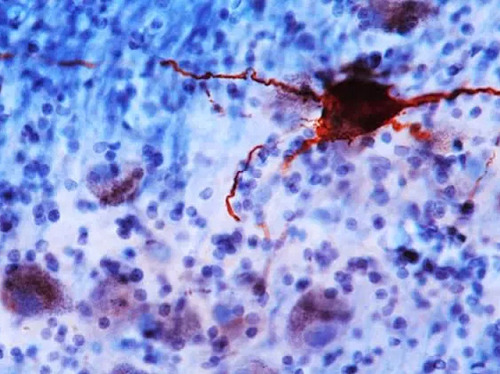
Early Signs
Alzheimer’s disease ravages the brain well before patients start to experience memory loss. In an ideal world, pre-symptomatic treatments could slow or even stop the eventual and irreversible degeneration of brain tissue. Unfortunately, these early stages can only be detected post-mortem, typically by looking for neurofibrillary tangles (shown in red in this brain section); these protein clusters are one of the earliest biological indicators of disease onset. However, scientists have recently shown that there may also be psychiatric indicators. Analysing post-mortem brains, the team found that individuals who hadn’t started experiencing memory loss but had neurofibrillary tangles in a particular brain region were more likely to have suffered from anxiety, changes in appetite, difficulties sleeping, and depression. Such symptoms aren’t necessarily causative, but may be a warning that the disease is picking up speed, so giving some hope of earlier diagnosis and even of new therapies to slow its onset.
Written by Gaëlle Coullon
- Image from the Grinberg Lab, UCSF
- Memory and Aging Center, Weill Institute for Neurosciences, University of California, San Francisco, San Francisco, CA, USA
- Image copyright held by the original authors
- Research published in the Journal of Alzheimer’s Disease, October 2018
You can also follow BPoD on Instagram, Twitter and Facebook
Archive link




Комментариев нет:
Отправить комментарий